Basal atelectasis - Study guides, Class notes & Summaries
Looking for the best study guides, study notes and summaries about Basal atelectasis? On this page you'll find 435 study documents about Basal atelectasis.
Page 4 out of 435 results
Sort by
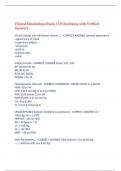
-
Clinical Simulations Exam 159 Questions with Verified Answers,100% CORRECT
- Exam (elaborations) • 20 pages • 2023
-
- $11.99
- + learn more
Clinical Simulations Exam 159 Questions with Verified Answers Visuals (things you will always choose...) - CORRECT ANSWER -general appearance -appearance of chest -respiratory pattern -sensorium -posture -patient color -pulse Infant normals - CORRECT ANSWER Pulse: 110 - 160 BP: 60/40 mm Hg RR: 30 to 60 Birth Wt: 3000g APGAR: 7 to 10 Hemodynamic Normals - CORRECT ANSWER BP: 120/80 (90/60 to 140/90) MAP: 93 to 94 CVP: 2 to 6 mm Hg (4 to 12 cmH2O) PAP: 25/8 (mean 13 to 14) PW...

-
NR 325 ADULT HEALTH FINAL GUDE.| VERIFIED GUIDE
- Exam (elaborations) • 40 pages • 2024
-
- $16.59
- + learn more
NR 325 ADULT HEALTH FINAL GUDE.| VERIFIED GUIDE 1. How does the nurse confirm a basal skull fracture when implementing evidence based practice? What is the nurses’ responsibility in each of these diagnosis? Types of skull fractures: linear or depressed, simple, comminuted or compound, open or closed. **Basilar fracture is a a specialized linear fracture involving the base of the skull (breaking of bones at the base of the skull.) Manifestations appear over several hours which includ...
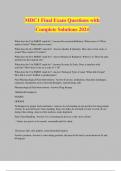
-
MDC1 Final Exam Questions with Complete Solutions 2024
- Exam (elaborations) • 12 pages • 2024
- Available in package deal
-
- $12.49
- + learn more
MDC1 Final Exam Questions with Complete Solutions 2024 What does the P in PQRST stand for? -Answer-Provocation/Palliation: What causes it? What makes it better? What makes it worse? What does the Q in PQRST stand for? -Answer-Quality & Quantity: How does it feel, look, or sound? How much of it is there? What does the R in PQRST stand for? -Answer-Region & Radiation: Where is it? Does the pain spread from the original site? What does the S in PQRST stand for? -Answer-Severity & Scale: Doe...
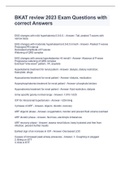
-
BKAT review 2023 Exam Questions with correct Answers
- Exam (elaborations) • 5 pages • 2023
-
Available in package deal
-
- $10.89
- + learn more
EKG changes with mild hyperkalemia 5.5-6.5. - Answer- Tall, peaked T-waves with narrow base. EKG changes with moderate hyperkalaemia 6.5-8.0 mmol/l - Answer- Peaked T-waves Prolonged PR interval Decreased amplitude of P-waves Widening of QRS complex EKG changes with severe hyperkalaemia >8 mmol/l - Answer- Absence of P-wave Progressive widening of QRS complex Eventual "sine-wave" pattern, VF, asystole Hyperkalemia treatment for renal patient - Answer- dialysis, dietary restri...
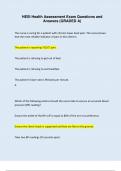
-
HESI Health Assessment Exam Questions and Answers (GRADED A)
- Exam (elaborations) • 112 pages • 2023
-
Available in package deal
-
- $11.49
- + learn more
The nurse is caring for a patient with chronic lower back pain. The nurse knows that the most reliable indicator of pain in this client is: The patient is reporting "6/10" pain. The patient is refusing to get out of bed. The patient is refusing to eat breakfast. The patient's heart rate is 90 beats per minute. A Which of the following actions should the nurse take to ensure an accurate blood pressure (BP) reading? Ensure the width of the BP cuff is equal to 80% of the arm...
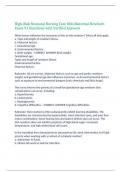
-
High-Risk Neonatal Nursing Care Olds Maternal-Newborn Exam 91 Questions with Verified Answers,100% CORRECT
- Exam (elaborations) • 34 pages • 2024
-
- $11.49
- + learn more
High-Risk Neonatal Nursing Care Olds Maternal-Newborn Exam 91 Questions with Verified Answers What factors influence the outcomes of the at-risk newborn? Select all that apply. a. Type and length of newborn illness. b. Maternal factors. c. Gestational age. d. Environmental factors. e. Birth weight. - CORRECT ANSWER Birth weight. Gestational age. Types and length of newborn illness. Environmental factors. Maternal factors. Rationale: All are correct. Maternal factors, such as age a...
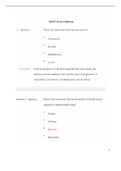
-
Chamberlain College of Nursing: NR507 Midterm Exam (Latest-2022, Version-1) / NR 507 Midterm Exam / NR507 Week 4 Midterm Exam / NR 507 Week 4 Midterm Exam: Advanced Pathophysiology |100% Correct Answers, Already Graded “A”|
- Exam (elaborations) • 44 pages • 2022
-
Available in package deal
-
- $15.49
- 3x sold
- + learn more
Chamberlain College of Nursing: NR507 Midterm Exam (Latest-2022, Version-1) / NR 507 Midterm Exam / NR507 Week 4 Midterm Exam / NR 507 Week 4 Midterm Exam: Advanced Pathophysiology |100% Correct Answers, Already Graded “A”| NR507 Week 4 Midterm Exam / NR 507 Week 4 Midterm Exam (Latest): Advanced Pathophysiology: Chamberlain College of Nursing Chamberlain NR 507 Midterm Exam / Chamberlain NR507 Midterm Exam (Latest): Advanced Pathophysiology 1. Question : What is the final stage of...
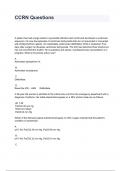
-
CCRN Questions With 100% C0rrect Answers
- Exam (elaborations) • 33 pages • 2024
-
- $13.29
- + learn more
CCRN Questions A patient has had a large anterior myocardial infarction last month and developed a ventricular aneurysm. He now has episodes of ventricular tachycardia that are not prevented or converted with antidysrhythmic agents. An implantable cardioverter-defibrillator (ICD) is implanted. Four days after surgery he develops ventricular tachycardia. The ICD has delivered three shocks but has not converted the rhythm. He is pulseless and apneic. Cardiopulmonary resuscitation is in ...
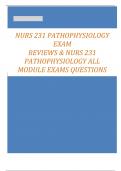
-
NURS 231 PATHOPHYSIOLOGY EXAM REVIEWS & NURS 231 PATHOPHYSIOLOGY ALL MODULE EXAMS QUESTIONS
- Exam (elaborations) • 184 pages • 2023
-
- $17.74
- + learn more
NURS 231 PATHOPHYSIOLOGY EXAM REVIEWS & NURS 231 PATHOPHYSIOLOGY ALL MODULE EXAMS QUESTIONS 202AND ANSWERS- Question 1 2.5 / 2.5 pts Question 2 0 / 2.5 pts Question 3 2.5 / 2.5 pts Path 231 examsreviews Exam 1 True/False: Persistent metaplasia can lead to dysplasia. True False True/False: Barrett esophagus is an example of dysplasia. True Correct Answer False True/False: Cervical intraepithelial neoplasia is a type of dysplasia. Question 4 0 / 2.5 pts Question 5 1...
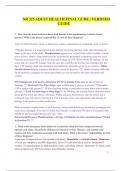
-
NR 325 ADULT HEALTH FINAL GUDE.| VERIFIED GUIDE
- Exam (elaborations) • 40 pages • 2023
-
- $13.39
- + learn more
NR 325 ADULT HEALTH FINAL GUDE.| VERIFIED GUIDE 1. How does the nurse confirm a basal skull fracture when implementing evidence based practice? What is the nurses’ responsibility in each of these diagnosis? Types of skull fractures: linear or depressed, simple, comminuted or compound, open or closed. **Basilar fracture is a a specialized linear fracture involving the base of the skull (breaking of bones at the base of the skull.) Manifestations appear over several hours which includ...

How much did you already spend on Stuvia? Imagine there are plenty more of you out there paying for study notes, but this time YOU are the seller. Ka-ching! Discover all about earning on Stuvia


